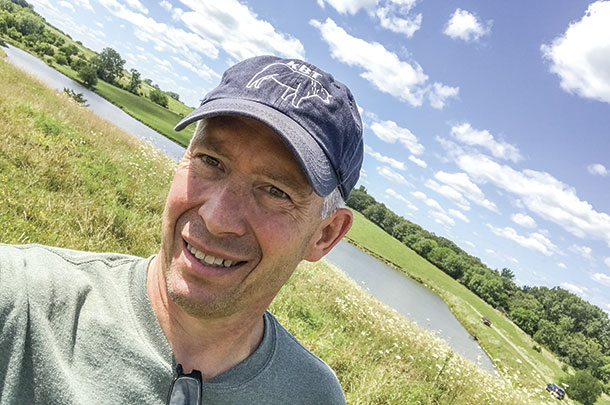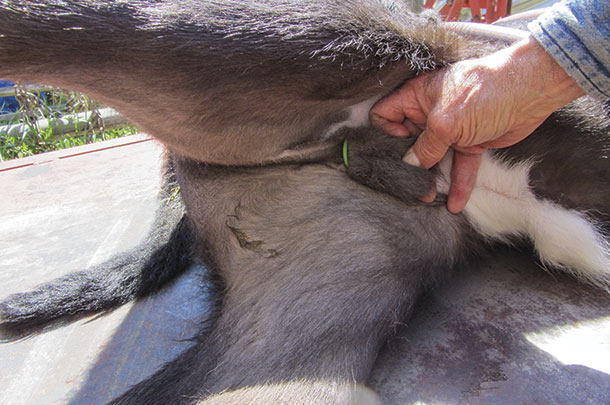“Some people leave bull calves intact, thinking to take advantage of natural growth hormones, but the next owner of those animals wants steers. Unless there’s some reason to keep that calf as a bull, there’s no reason to wait. Anyone buying steers prefers that they are already castrated. If a calf is already 400-plus pounds, it’s more stressful to castrate at that age, with setback in growth and gain,” he says.
“Many small producers don’t castrate calves, but this creates a risk for the next owner [usually a feedlot]. In the South and Southeast, many producers have town jobs and small herds they handle infrequently. They may gather cattle once a year and sort off calves to wean and take to the sale barn. This may be the only time they’ve ever handled those calves. I can understand this, but they need to start thinking about the next person who owns those animals,” Meyer says.

Dan Thomson, Kansas State University professor of production medicine and epidemiology, says some people might think weaning weights will be lower if they castrate at birth, but research shows no difference between cattle castrated at birth and cattle left intact until weaning. “There’s no advantage in waiting, and if calves aren’t castrated before coming to the feedlot, there’s a huge increase in sickness and death loss.”
Castration and dehorning are necessary procedures, but not as painful and stressful when calves are young. “The earlier, the better as long as we wait until those little guys have a chance to get colostrum and bond with mom. When we put in an eartag, that’s the time to castrate and disbud if they’ll have horns,” Thomson says.
Baby calves take it in stride and go right back to suckling and playing. Calves castrated at branding age might lie around for part of a day but usually bounce back quickly. It makes some difference how old they are at branding time, whether 3 weeks or 3 months old. On large ranches where cows calve out on the range, there’s usually no good way to catch and process calves in the first days of life.

Thomson recommends doing it as young as possible, since short-term pain at a young age is less stressful. “There are new products to make it easier to band baby calves. Callicrate has a new one called the Wee Bander, a high-tension banding tool designed for newborns. It has a good way to apply tension so you don’t have to worry about a testicle slipping back up before you are finished,” he says. This is the challenge with the old elastrator pliers and elastic “cheerio” rings on young calves. You have to make sure both testicles are still below the ring before you remove the tool.
“The Wee Bander is like the Easy Bander but smaller and enables you to tighten that band after you get it in the proper spot. The old elastrator is either spreading the band or not, and the tension you get is only what’s in the rubber band. This new method increases tension and helps it stay in place. It has its own band, and you crimp it off, like the Easy Bander, to apply tightness and pressure,” Thomson says.
“We first want to make sure the calf has suckled and obtained colostrum, so I usually give them a day,” says Thomson. “The next day, when I tag and weigh that calf, I go ahead and castrate and disbud. If producers can’t do it that early, they should castrate at branding or when doing pre-breeding vaccinations for cows and giving calves their first vaccinations. People either put the calves on the ground or use a tilt table.”
“When castrating, it may be beneficial to talk with your veterinarian about what kind of technique is recommended in your area. If you are going to band calves, it’s wise to give a tetanus toxoid, though the jury is still out on whether it’s effective when they are only a day old. If you are giving blackleg vaccine to baby calves or at branding age, add tetanus if you are going to band them,” he says. When you apply a band, you create an area of the body where there’s no blood supply, which makes ideal conditions for tetanus.
“I recommend working with your veterinarian, not just on vaccinations but also on technique. Some producers watch me castrate, to learn how to do it safely and efficiently – not just for ease on the calf but also on themselves. People who do it all the time learn tips and tricks, and knowing these might save you a front tooth or a bad back. It’s not just about technique but also about safety and self-preservation,” Thomson says.
“If a person wants peace of mind, it doesn’t hurt to have the veterinarian do the castrating when processing a lot of calves.”
When calves are just a day or two old, it doesn’t matter whether you band or cut them. “They bounce right up afterward if you do it correctly; either knife cut or banding is acceptable,” Thomson says.
The most important thing is finding a technique you are comfortable with and good at. “I’d rather have someone who is really good at banding just keep banding, instead of suddenly deciding to knife cut. The main thing is developing a technique and doing it while the calves are young,” he says.
Meyer prefers to cut rather than band, even on very young calves. “This is the best way to make sure you get both testicles. When cutting them young, there is less risk for serious bleeding than when they are bigger,” he says. Banding may be easier for some people, and they may feel it’s safer because there’s no bleeding and possibly less risk for infection, but it must be done correctly or there are additional risks. If the band is not completely above the testicles and catches on one, this creates ongoing pain and a serious health risk. If you only get one (and the other testicle is above the band), you end up with a stag (bull characteristics).
“Every year, some people buy calves they thought were steers, and a few of them still had a testicle,” says Meyer. “That’s one reason I am not in favor of banding small calves: If you cut them, you know you got both testicles. If you worry about bleeding, just use a clamp and leave it on temporarily to crush that vessel,” he explains.
“Even though banding is simple, quick and bloodless, I’d rather cut them. I think the discomfort is less and for a shorter time,” says Meyer. There is some discomfort and irritation from the band until the dead tissue of the scrotum dries up and falls off, and the raw area heals.
The time of year you calve may make a difference, whether the calves are in a muddy pen in late winter or on green pasture later in the year. What works for one person may not work for another. “Each farm and ranch is different, and producers must figure out what works best for their own situation – and not everything works best in the same place every year because of weather and other factors,” says Thomson.
“It’s important to keep everything clean when cutting calves,” says Meyer. “I suggest keeping your equipment in a bucket of water with disinfectant. Chlorhexadine has the broadest spectrum of activity against a variety of pathogens and non-irritating to the tissues. Make sure the scrotum is clean. Use clean equipment, then follow up with disinfectant spray. If it’s a time of year when there are flies, use a fly-repellent product around the scrotum or wound area as well,” says Meyer.
“Castration and painful procedures are discussed by the American Association of Bovine Practitioners. Pain control and things people want us to use when castrating bigger bulls will require a veterinarian,” says Thomson. This can be avoided if castration is done when calves are young and small.
“Things like immune castration may be something we’ll use in the future as the technology improves. There would be some benefit if you could castrate an animal with injections rather than surgically or banding. But there’s also the question of consumer acceptance of beef from animals castrated with hormonal manipulation,” says Thomson.
With the methods in use today, our best and most humane options are to castrate calves as young as possible. “I always tell my students that the longer the testicles are attached to the calf, the more attached the calf is to them. It’s always harder on him to lose them when he’s older.” As an industry, we need to continue to do the right things that improve the health and well-being of our cattle. ![]()
PHOTO 1 & 3: Castration administered at a younger age can be better for younger calves that can recover quickly from pain. Photos provided by Heather Thomas.
PHOTO 2: Dan Thomson of Kansas State University. Photo provided by Dan Thomson.
Heather Thomas is a freelance writer based in Idaho.








